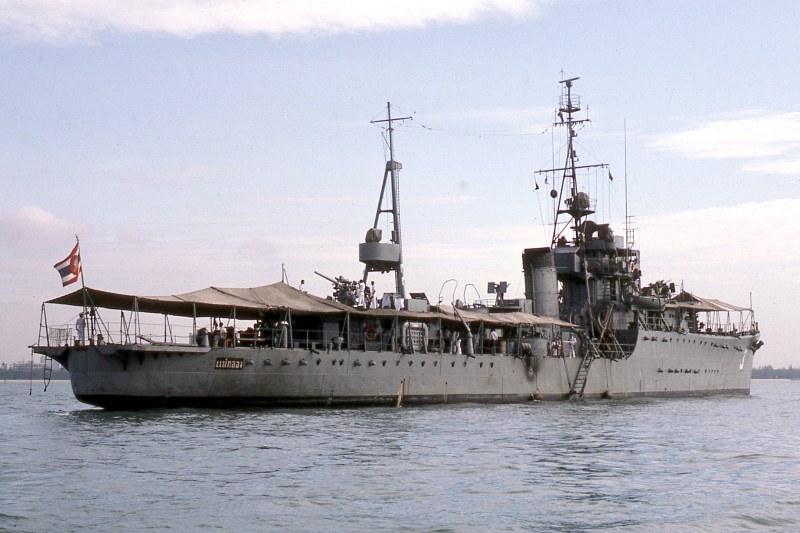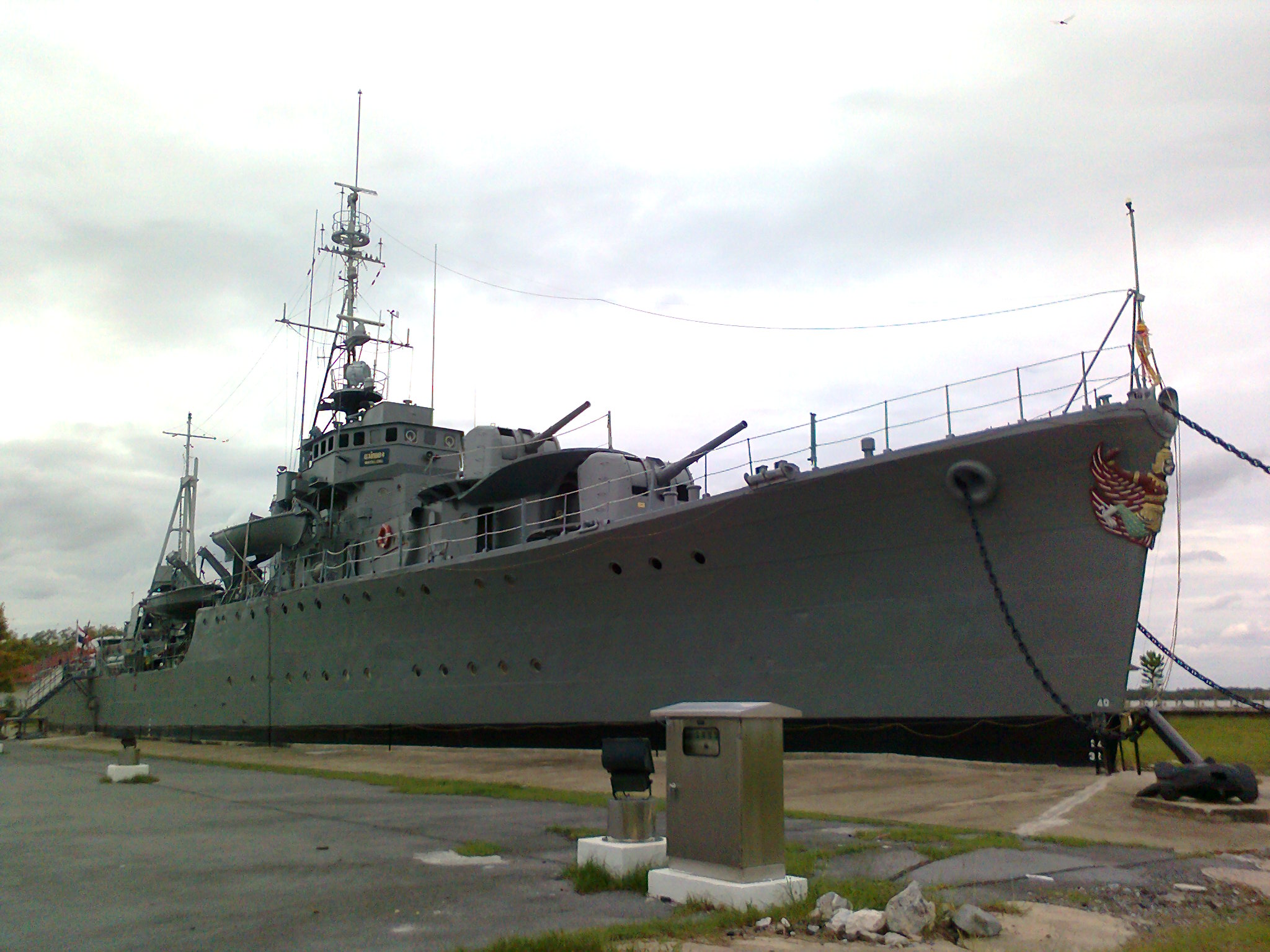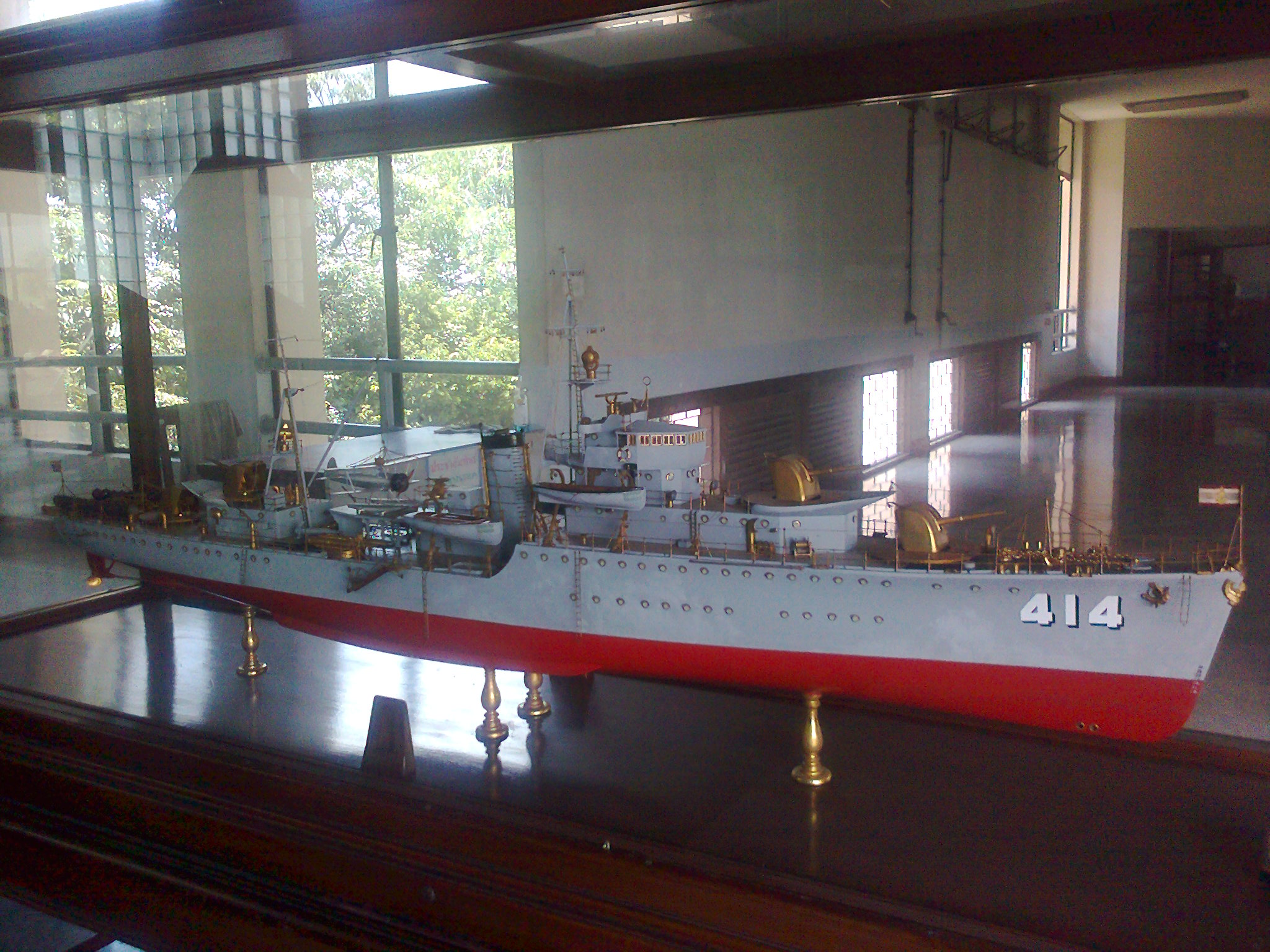- Yes
- No
Hello, today I would like to suggest the addition of the Maeklong-class frigate, HTMS Maeklong. This is the last World War II-era Japanese-built warship still inact. Despite her relatively small size, the ship is packed with destroyer level of armaments, including a seaplane catapult.
The HTMS Maeklong encased in concrete at the Chulachomklao Fort.
On 13 August, 1935, the Royal Thai Navy ordered five ships from Japan as a part of the fleet modernization plan. Two of the ship were the Maeklong-class frigate (or sloop depending on the source) consists of the HTMS Maeklong and HTMS Tachin. The ship were designed to be capable as a training ship during peacetime and a competent warship during wartime. As such, the ship were to be armed with destroyer-level weaponry, namely four 120 mm 3rd year Type gun (a standard-issued gun for the Japanese destroyer at that time), four 450 mm Type 8 torpedoes launched from twin launchers on the port and starboard side, three 40 mm/62 Shiki autocannons (a Japanese copy of the Pom-pom autocannon), one twin-mounted Danish-built 20 mm Madsen anti-aircraft guns, and unusually, one Watanabe RTN.1 seaplane based on the Watanabe E9W submarine-launched seaplane specifically built for the ship’s catapult located on the midship section.
Scale model of the Maeklong in her 1954 fit. Note the RTN.1 seaplane on the midship section.
Maeklong’s keel was laid down on 24 July 1936 and launched the same year. The ship were delivered to Thailand on 26 September 1937 and were assigned as a training ship. Prior to the World War II, the ship were used as a royal ship when the young king Ananta Mahidol (Rama VIII) and the royal family moved to Switzerland to study there.
Maeklong (back) and her sister ship Tachin, circa 1939.
During the Franco-Thai war in September 1940, Maeklong and her sister ship Tachin were assigned to patrol around the Gulf of Thailand. Then, as Thailand officially entered World War II on the Axis side on December 1941, both ship were then assigned for coast guard duties until the end of the war in 1945. Wartime services for both ship were largely unevenful until June 1945 when the Tachin was attacked by a fleet of British aircrafts and were hit by 250 kg bomb, causing crippling damage that prompted the RTN to scrap her after the war.
In 1949, the Maeklong once again sailed under the royal entourage, this time to bring bone ash of King Prajadhipok (Rama VII) back home, and again in 1951 for the return trip of King Ananta Mahidol and family. In 1954, the ship underwent a minor modernization, replacing a single-mount Breda autocannon with a twin-mount version and adding depth charge launchers at the stern.
The RTN.1 Seaplane on board the Maeklong.
Midship section of the Maeklong, 2005, note the twin 20 mm Madsen autocannons mount and a canvas covering where the seaplane catapult were once located.
As a training ship, the Maeklong underwent several modernization throughout her 59-year services. Her first modernization in 1951 replaced three Japanese 40 mm and 20 mm Madsen autocannons with three 40 mm Bofors L60 and three 20 mm Oerlikon autocannons, respectively. Along with the addition of surface and underwater radar, depth charge and mine launchers. Her second modernization took place in 1973, replacing the aging Japanese 120 mm cannons with four American 76 mm Mk. 22 semi-automatic cannons and removing the plane catapult almost entirely.


The Maeklong as she appeared between 1973 - 1995. Note the Oerlikon autocannon mounts on the bridge and on the place where the Madsen once stood.
After serving for 59 years and trained three generations of RTN personnel, the Maeklong were retired in 1995, making her the longest-serving ship of the Royal Thai Navy to date. As per the request of King Bhumibol Adulyadej, the ship were preserved and restored to resemble her 1936 configuration, the 76 mm were replaced with the Japanese 120 mm guns and the twin 20 mm Madsen autocannons mount were reinstalled onto its former location. The HTMS Maeklong is currently a museum ship located at the Chulachomklao Fort, Samut Prakarn province.
Given her origin, her history and importance to the Royal Thai Navy, I think the Maeklong will be a fine addition to the Japanese coastal tree. Due to heavy armament for her class and capability of carrying seaplanes, the ship offers utility as a base cature and choke point defender. Since the ship have different ref
Specifications:
Displacement: 1,422 tons full load
Length: 82 meters
Beam: 10.36 meters
Draft: 3.14 meters
Polpusion system: 2 reciprocating steam engines
Power: 2,500 h.p.
Top speed: 17 knots (31 km/h)
Armaments:
Spoiler
1936: 4 x 1 120 mm 3rd year Type cannons, A-B-X-Y, 1 x 2 20 mm Madsen AA guns at the midship section, 3 x 1 40 mm/62 Shiki AA guns, 2 x 2 450 mm Type 8 torpedoes, 1 x RTN.1 seaplane
1951: 4 x 1 120 mm 3rd year Type cannons, A-B-X-Y, 3 x 1 20 mm Oerlikon AA guns, one at the midship section, two in front of the bridge, 3 x 1 40 mm Bofors L/60 AA guns, 2 x 2 450 mm Type 8 torpedoes, 1 x RTN.1 seaplane, 2 x depth charge mortars, 2 x mine racks
1973: 4 x 1 76 mm Mk. 22 cannons, A-B-X-Y, 3 x 1 20 mm Oerlikon AA guns, one at the midship section, two in front of the bridge, 3 x 1 40 mm Bofors L/60 AA guns, 2 x 2 450 mm Type 8 torpedoes, 2 x depth charge mortars, 2 x mine racks
Crew: 173
Spoiler
Sources:
Mikesh, Robert C. and Shorzoe Abe. Japanese Aircraft 1910–1941. London: Putnam, 1990. ISBN 0-85177-840-2.
Gardiner, Robert and Roger Chesneau. Conway’s All The World’s Fighting Ships 1922–1946. London: Conway Maritime Press, 1980. ISBN 0-85177-146-7.
museumships.us - Your most complete source for Museum Ships Worldwide! - Maeklong
https://www.navy.mi.th/index.php/history/detail/history_id/18714 (in Thai)
เทคโนโลยีและประวัติศาสตร์ด้านการทหารกองทัพไทยและกองทัพทั่วโลก : The Power of the Sea : โครงการบำรุงกำลังทางเรือ พ.ศ. 2478 (in Thai)
เรือหลวงแม่กลอง – Seafarer Library (in Thai)
http://navy24.org/เรือหลวงแม่กลอง-ยอดเรื/ (in Thai)




